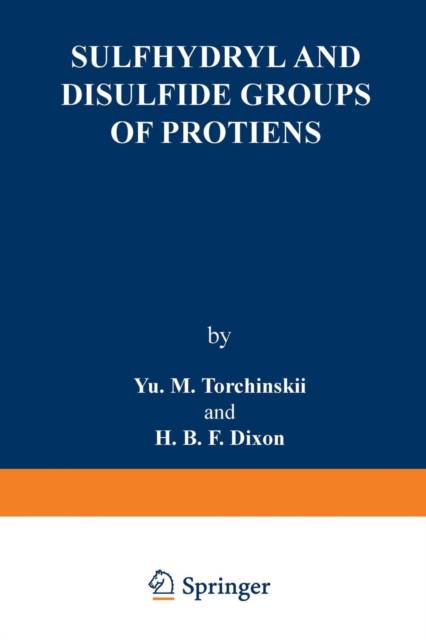
Door een staking bij bpost kan je online bestelling op dit moment iets langer onderweg zijn dan voorzien. Dringend iets nodig? Onze winkels ontvangen jou met open armen!
- Afhalen na 1 uur in een winkel met voorraad
- Gratis thuislevering in België vanaf € 30
- Ruim aanbod met 7 miljoen producten
Door een staking bij bpost kan je online bestelling op dit moment iets langer onderweg zijn dan voorzien. Dringend iets nodig? Onze winkels ontvangen jou met open armen!
- Afhalen na 1 uur in een winkel met voorraad
- Gratis thuislevering in België vanaf € 30
- Ruim aanbod met 7 miljoen producten
Zoeken
Omschrijving
(Written for the original Russian edition) Out of all the functional groups of protein molecules that be- long to the side chains of amino acid residues, the sulfhydryl or thiol (SH) groups of cysteine residues and the disulfide (S-S) groups of cystine have for long attracted particular attention from chemists and biochemists. This is due, on the one hand, to the high chemical reactivity of these groups, which enter into many, and often very characteristic and selective, reactions with several types of compound. On the other hand, this attention is connected with the great significance of SH and S-S groups for the specific functions of a number of enzymes, hormones, and other biological- ly active proteins, and consequently for the normal course of many physiological processes. The varied functions of sulfhydryl and disulfide groups in en- zymes are particularly interesting; their role can consist of bind- ing substrates and cofactors, in direct participation in the catalytic act, or in maintaining (in ways not so far sufficiently studied) the native, catalytically active conformation of the protein. It is entirely natural that the detailed study of the chemical behavior and biological role of these sulfur-containing groups in proteins (and in such low-molecular cofactors as glutathione, co- enzyme A, lipoiC acid, etc. ) has, in addition to its academic, gen- eral biological interest, great Significance for many applied branches of medicine and biology (toxicology, radiobiology, diagnostics and therapeutics, biochemical engineering, plant growing, etc. ).
Specificaties
Betrokkenen
- Auteur(s):
- Uitgeverij:
Inhoud
- Aantal bladzijden:
- 275
- Taal:
- Engels
- Reeks:
Eigenschappen
- Productcode (EAN):
- 9781475701296
- Verschijningsdatum:
- 15/01/2013
- Uitvoering:
- Paperback
- Formaat:
- Trade paperback (VS)
- Afmetingen:
- 152 mm x 229 mm
- Gewicht:
- 385 g

Alleen bij Standaard Boekhandel
+ 167 punten op je klantenkaart van Standaard Boekhandel
Beoordelingen
We publiceren alleen reviews die voldoen aan de voorwaarden voor reviews. Bekijk onze voorwaarden voor reviews.











